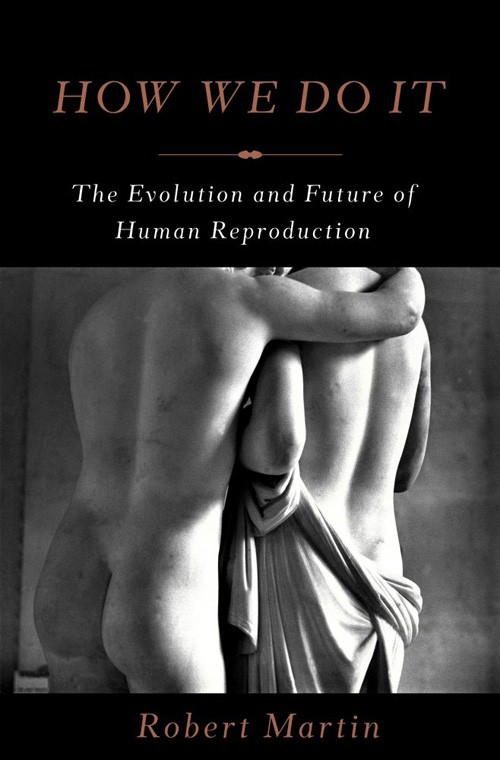Human beings would probably be known as pilosals rather than mammals if Carl Linnaeus had not been a proponent of breast-feeding. For social and political reasons, the famed taxonomist labeled the class of animals to which humans belong with a reference to their practice of suckling their young rather than to their evolutionarily older characteristic of having hair.
This is just one of the hundreds of surprising pieces of information that readers will glean from the far-reaching and fascinating How We Do It: The Evolution and Future of Human Reproduction, a new book by Robert Martin, a member of the University’s of Chicago’s Committee on Evolutionary Biology and curator of biological anthropology at the Field Museum.
Readers will also learn that:
- Sex cells do not vary in size among mammals. All mammal eggs are the same size—from those of a tiny mouse to those of a huge elephant. And the same is true for mammal sperms.
- The relative size of human testes indicates that we evolved to live in social groups with one-male breeding units practicing either monogamy or polygamy, usually the latter.
- At the end of the Ming Dynasty there were some 70,000 eunuchs in the service of the emperor.
- Today there are half a million frozen embryos stored in the United States.
But what’s the point? Good cocktail party conversation?
In fact, it was precisely such a question that prompted Martin to write this book. Years ago, when he had just finished teaching a course on primate evolution at the University of Zurich, a student asked him, “So what? What’s the utility of studying this subject?”
Robert’s initial reaction was to say, “Primate evolution is important in its own right, but it’s also human history—our history—going far back in time.”
Nevertheless, the student’s question stuck with him. “I realized that my research had practical applications,” Martin says, “so I wrote this book to connect primate evolution with modern human concerns and conditions.”
Indeed, the book is full of pertinent facts, figures, anecdotes, and analysis about human evolution, expertly woven together to inform current issues, including birth control, enhanced reproductive techniques, miscarriage, cloning, breast-feeding, the effects of toxins on human reproduction, and the dramatic drop in sperm counts—all synthesized into a comprehensive synopsis of how we got where we are today, as a species, and where we’re headed.
Scintillating, not titillating
In one of the more controversial sections, Martin challenges the conventional medical stance that conception can occur only four days before and one day after ovulation. He demonstrates that conception can occur following insemination on any day of a woman’s 28-day menstrual cycle but especially during a period between nine days before and one day after ovulation.
Along with this, Martin reviews evidence showing that sperm can survive in a woman’s reproductive tract for more than a week and that sperm not only swim toward the egg but also are propelled along by muscle contractions in the woman’s womb and oviducts. If recognized, these ideas could change the way enhanced birth techniques are implemented.
Many of Martin’s conclusions come from studying reproduction in other primates and thereby knowing what to look for in humans. Also, the author has drawn on a huge wealth of resources over 40 years, some of them available in only French or German.
Martin discusses many fascinating yet still unanswered questions about primate reproduction: Why do women produce only a few hundred mature eggs while men, over a lifetime, produce up to 4 trillion sperm cells? Why are humans born with such big heads? Why are rhesus monkeys but not humans prone to “sperm warfare?” Do men “wander” as an evolutionary adaptation to avoid inbreeding? What is the evolutionary advantage of live births?
Martin does, however, answer the age-old question of which came first, the chicken or the egg? “The egg, of course,” he writes. “Chicken, like people, evolved so that one egg could lead to another.”
Aimed at the general public, this book handles complex topics clearly and succinctly, and includes a helpful glossary. Martin’s light touch and sense of humor will keep readers turning the pages. For instance, he suggests that each ejaculation has an average of 250,000,000 sperm because not one of them is likely to stop along the way to ask for directions.
Martin also hits hard at practices and institutions that he thinks fly in the face of science. He faults the Catholic Church for opposing both birth control and modern methods to artificially enhance conception. “It beggars belief that minor interventions in human reproductive biology can provoke religious outrage, whereas the castration of young boys simply to embellish the choir … was encouraged until the beginning of the 20th century,” he writes.
Martin says the subject of his book can be prone to misinterpretation, even by the book’s publisher, which discarded his preferred title (Natural Mothers) and tried to put a suggestive image of a half-peeled banana on the cover. That would have missed the point of his book, which strives to be frank but not puerile.
“My book is not an extended dirty joke,” Martin said, “but rather a serious, scientific treatment of the evolution of human reproduction based on a career’s worth of research and reflection.”
– By Greg Borzo
*Source: The University of Chicago

